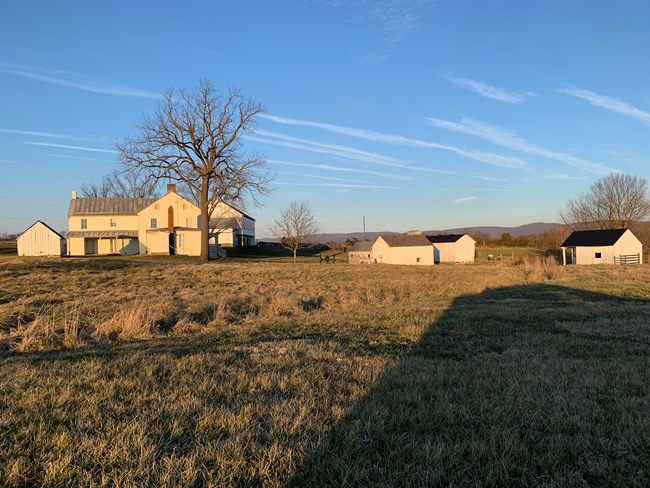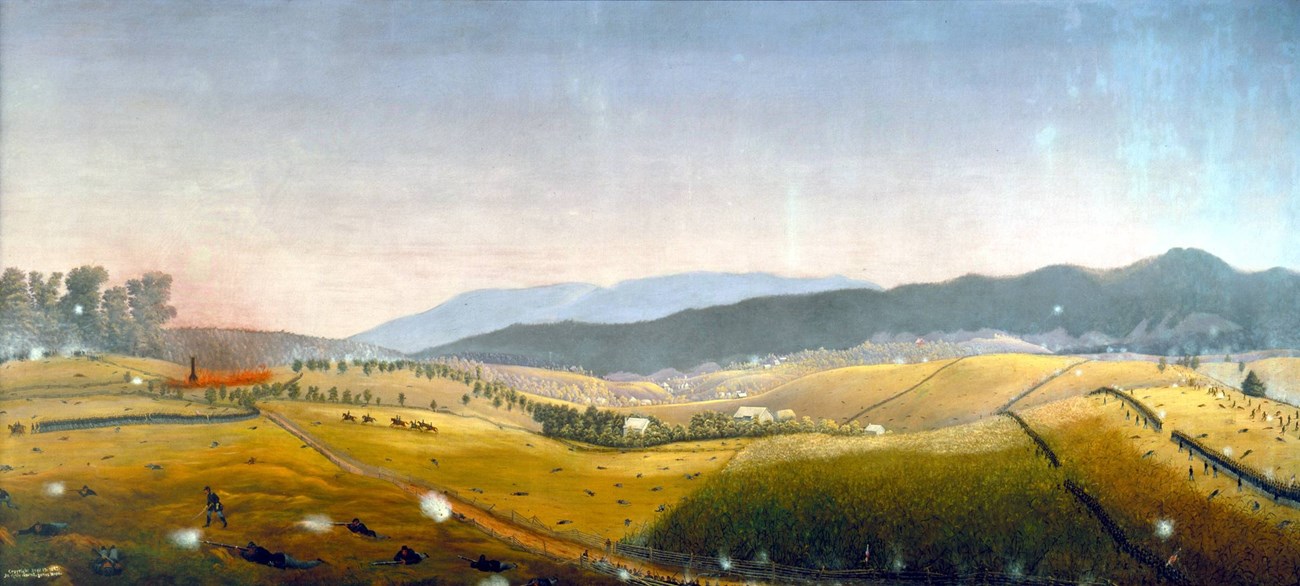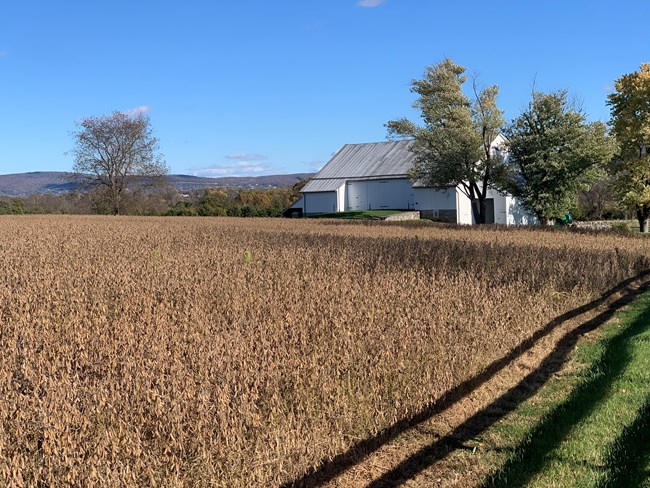The Mumma Family and Farm: A Story of Forgiveness and RecoveryForgiveness“As to your burning our house, we know that in doing so, you were carrying out orders.” This was Samuel Mumma Jr.’s response to Sergeant James F. Clark of the 3rd North Carolina Infantry who wrote to the postmaster of Sharpsburg, Maryland in March of 1906. When Clark sought information about the family whose home he helped destroy in the battle of Antietam on September 17, 1862, he had no way of knowing that the postmaster who received his letter was actually Samuel Mumma Jr., the son of the owner of that farm. Samuel wrote back to Clark and informed him of the Mumma family’s experience during and after the battle. He outlined the damage done to their family and ended with his acceptance of Clark’s actions. To understand the magnitude of Samuel Jr.’s act of forgiveness, we must understand what the Mumma family lost that fateful September day. 
NPS Antietam / B.Baracz The Mummas and Their FarmAt the time of the battle of Antietam, Samuel Mumma Jr. lived with his parents, Elizabeth and Samuel Sr., and nine of his siblings on their 151-acre farm. Members of the German Baptist Brethren, their ancestors had fled religious persecution in the Rhine River Valley. They first arrived in Philadelphia in 1732. They settled in Lancaster, Pennsylvania and remained there until May of 1796. At that time, Jacob Mumma moved his family to the Sharpsburg area. In the following years, Jacob purchased the property that would become the Mumma farm. Jacob bought the land from the Orndorff family who built the original home, barn, and outbuildings. Jacob’s son, John, was the first Mumma to live there. During this time, the family expanded the home with a two-story brick addition. After this modification, the house looked very similar to how it does today, save for a first-floor addition built in 1919. In 1831, Jacob sold the house and land to his youngest son, Samuel Mumma, Sr. Samuel successfully farmed the property for next 30 years. In 1860, the value of their farm totaled $11,000, well over $300,000 adjusted for inflation to 2020 dollars. Along with running a thriving farm, Samuel Sr. was father to a large family. He married Barbra Hertzler in 1822. The couple had five children, including a son who died in infancy. In 1833, their last child, a daughter, was born. The baby and Barbara tragically died shortly after the birth. Samuel remarried a few months later to Elizabeth Miller. Samuel and Elizabeth had eleven children, one of whom, Samuel Mumma Jr., would later go on to become the postmaster of Sharpsburg and receive Sergeant James F. Clark’s letter. 
NPS Antietam Battlefield A Family Forever ChangedSunday, September 14, 1862 began just like any other for the Mummas. Being German Baptist Brethren or “Dunkers,” the family started their day by walking the short distance from their home to a small white church on the western edge of their property. That church, the Dunker Church, stood on a 4.5-acre plot of land that the Mummas had donated to the congregation. This place of peace was where the Mummas would spend the morning of September 14, unaware that life would soon change forever. During the church service, they began to hear the rumble of artillery fire as the Battle of South Mountain raged just six miles to the east. Following the end of services, members of congregation gathered at the Mumma farm for an uneasy noontime meal. The children, who had been playing outside in the yard, ran inside to report growing clouds of smoke forming on the mountain. War had come to this peaceful community. By the next morning, soldiers had arrived in the area and the people of Sharpsburg realized that another battle would soon take place. Samuel Jr. described his family’s experience as they fled to safety: “My father was told the family had better get away, so we left on Monday afternoon the 15th, took nothing with us as they were cannonading then, and we were afraid there would be a great battle at once. Some clothing was gotten together and the silverware packed in a basket, ready to take but in our haste to get away, all was left behind. Father and mother and the younger children left in the two-horse carry … all going about four miles, and camped in a large church called the Manor Church.”1 In their haste to leave, the only thing the Mummas brought with them was a gold pocket watch that Samuel Sr. grabbed on his way out of the house. He hung it around his youngest child’s neck to calm her as they fled their home. The family sheltered at Manor Church safe from the battle. However, when they returned, they found that all they owned was gone. The Mumma home was the only structure deliberately destroyed during the battle. Around 6:30 am, Brigadier General Roswell S. Ripley, whose brigade had been stationed to the south and west of the Mumma farm, ordered his troops to burn the home. He was concerned that enemy sharpshooters would use the structure as cover to pick off his Confederate soldiers. Members of the 3rd North Carolina Infantry led by Sgt. James F. Clark volunteered for the task. Clark, “recalled throwing a torch through an open window and onto a quilt covered bed. Within a few moments the whole house was in flames.”2 The fire would quickly spread, and by 7:30, the house and outbuildings were in flames. A stray Union artillery shell would set the barn ablaze and completed the total destruction of the Mumma farm. The soldiers who fought on the northern end of the field witnessed the fire raging from about 6:30 to 11:00 am. The bright flames and mass of smoke further added to the confusion and chaos of the battlefield. A soldier of the 83rd New York remarked that, “just in front of us a house was burning, and the fire and smoke, flashing of muskets and whizzing of bullets, yells of men …were perfectly horrible.”3 Night brought an end to the fighting, but the nightmare for the Mummas had just begun. 
NPS Antietam / B.Baracz Destruction and RecoveryThe family returned on September 19. All that remained of their once prosperous farm was the stone shell of their springhouse and three brick walls of their home. The Mummas, left with nothing, stayed at the home of their neighbor, Joseph Sherrick, through the winter of 1862. It took nine months, but the Mumma family rebuilt their home using the surviving brick walls. They moved back in in June of 1863, just before the Confederate army once again moved through the area on its way to Gettysburg. The Mummas, like their neighbors, petitioned the federal government for compensation for the loss of their home. Government officials refused on the grounds that Confederate, not Union, soldiers were responsible for the burning of the home. The Mummas never received a dime for what they lost. Despite this, with the help of friends and family, they were able to rebuild and return to their farm. The family attempted to move on and forget about those horrible September days. They were successful until that day in March of 1906 when Sergeant James F. Clark’s letter arrived. We can never know why Samuel Mumma Jr. responded so kindly to Sergeant Clark. But Samuel Mumma Jr.’s words of forgiveness serve as a reminder that compassion can be found even in the worst of circumstances. The farm remained in the family until 1885, when it was sold to Rezin D. Fisher. The property changed hands several more times until it was purchased by the National Park Service in 1961. The Park Service would allow the owners, Hugh and Hattie Spielman, to live there until 1985. In the mid-2000s, the Mumma house and farm became the park’s Education Center. Today, thousands of children come every year to learn about the battle of Antietam and the story of the Mumma family. The Mumma Education Center serves to preserve the memory of the Mumma family and how through tremendous struggle and hardship, they were able to rebuild and forgive. 
NPS Antietam / K.Snyder |
Last updated: September 15, 2023
